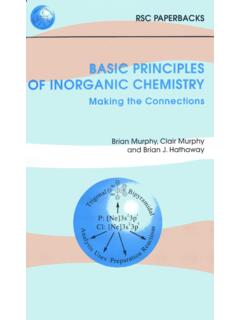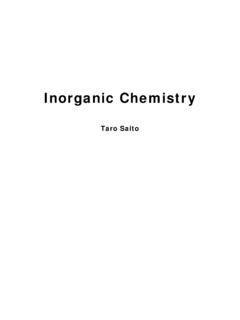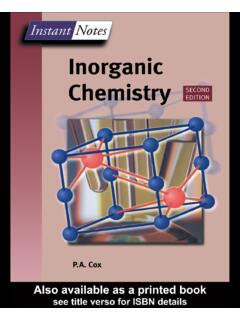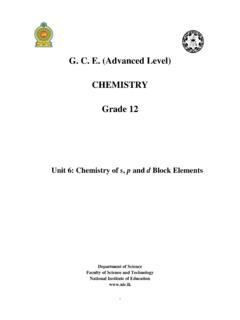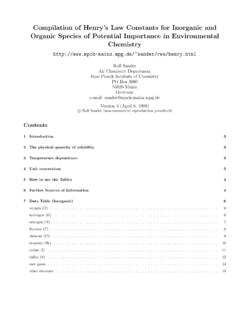Transcription of Chemistry - Edexcel
1 Centre NumberCandidate NumberWrite your name hereSurnameOther namesTotal MarksPaper ReferenceTurn over P49837A 2016 Pearson Education *P49837A0120*ChemistryAdvanced SubsidiaryPaper 1: Core inorganic and Physical ChemistryFriday 27 May 2016 MorningTime: 1 hour 30 minutes8CH0/01 You must have: Data BookletCalculatorInstructions Use black ink or ball-point pen. Fill in the boxes at the top of this page with your name, centre number and candidate number. Answer all questions. Answer the questions in the spaces provided there may be more space than you The total mark for this paper is 80. The marks for each question are shown in brackets use this as a guide as to how much time to spend on each question. You may use a scientific calculator. For questions marked with an asterisk (*), marks will be awarded for your ability to structure your answer logically showing the points that you make are related or follow on from each other where Read each question carefully before you start to answer it.
2 Try to answer every question. Check your answers if you have time at the end. Show all your working in calculations and include units where Edexcel GCE2*P49837A0220* DO NOT WRITE IN THIS AREA DO NOT WRITE IN THIS AREA DO NOT WRITE IN THIS AREAA nswer ALL questions must be answered with a cross in a box . If you change your mind about an answer, put a line through the box and then mark your new answer with a cross .1 This question is about Group 7 elements and their compounds. (a) (i) Give the physical states of chlorine and iodine at room temperature and pressure.(1).. (ii) Predict the physical state of astatine under these conditions. Justify your answer.(1).. (b) Write the equation for the reaction of chlorine with cold, dilute sodium hydroxide solution to form bleach. Name this type of reaction.(2)Type of reaction .. (c) Hydrogen bromide gas reacts with ammonia gasHBr + NH3 r NH4Br What would be observed during this reaction?(1) A bubbles B decolorisation C steamy fumes D white smoke3*P49837A0320*Turn over DO NOT WRITE IN THIS AREA DO NOT WRITE IN THIS AREA DO NOT WRITE IN THIS AREA (d) State what is meant by the term electronegativity and hence explain the polarity, if any, of the bonds in chlorine trifluoride, ClF3.
3 (3).. (e) What is the number of ions in g of magnesium chloride, MgCl2? [Avogadro constant = 1023 mol 1](1) A 1022 B 1023 C 1023 D 1023(Total for Question 1 = 9 marks)4*P49837A0420* DO NOT WRITE IN THIS AREA DO NOT WRITE IN THIS AREA DO NOT WRITE IN THIS AREA2 This question is about the structure of the atom and isotopes. The following excerpt is taken from the book inorganic Chemistry by Bailey and Snellgrove, fourth impression 1938. Some of the electrons are also contained in the nucleus, whilst the remainder are .. arranged in rings revolving round the nucleus .. The two isotopes [of chlorine] have therefore 18 and 20 electrons respectively in the nucleus and 17 [electrons] external to it. (a) Identify and correct two errors in the excerpt.(2).. (b) What is the structure of a 1+ ion of the carbon-13 isotope?(1) A six protons, six neutrons and five electrons B six protons, seven neutrons and six electrons C six protons, seven neutrons and five electrons D seven protons, six neutrons and six electrons (c) (i) State what is meant by the term relative atomic mass.
4 (2).. 5*P49837A0520*Turn over DO NOT WRITE IN THIS AREA DO NOT WRITE IN THIS AREA DO NOT WRITE IN THIS AREA (ii) A g sample of lithium, containing the two isotopes lithium-6 and lithium-7, was found to contain g of the isotope lithium-6. Calculate the relative atomic mass of lithium for this sample. Give your answer to an appropriate number of significant isotopic (3) (d) A mass spectrometer was used to analyse a sample of bromine, Br2, with only the 79Br and 81Br isotopes present. Explain why a very small peak occurs at m/z = 80.(2)..(Total for Question 2 = 10 marks)6*P49837A0620* DO NOT WRITE IN THIS AREA DO NOT WRITE IN THIS AREA DO NOT WRITE IN THIS AREA3 A student used the apparatus in the diagram to determine the molar volume of a cm3measuring cylindertroughdilute hydrochloric acidmagnesium ribbondeionised waterAssume clamps are in place to secure the apparatus The student used a piece of magnesium ribbon, which was about 5 cm in length, and the dilute hydrochloric acid was in excess.
5 The experiment was repeated three times at 24 C and the following results were 1 Experiment 2 Experiment 3 Mass of magnesium / of hydrogen gas / cm3312532 The equation for the reaction isMg(s) + 2 HCl(aq) r MgCl2(aq) + H2(g) (a) (i) Calculate the number of moles of magnesium used by the student in each experiment.(1) (ii) Use your answer from part (a)(i) to deduce the number of moles of hydrogen gas that should be produced.(1)7*P49837A0720*Turn over DO NOT WRITE IN THIS AREA DO NOT WRITE IN THIS AREA DO NOT WRITE IN THIS AREA (iii) Calculate, using the Ideal Gas Equation, the volume of hydrogen gas, in cm3, that should be produced in each of these experiments. [pV = nRT R = J mol 1 K 1 p = 101 000 Pa](4) (b) Give a reason why the student repeated the experiment three times.(1).. (c) Give three reasons for the difference between your calculated value in (a)(iii) and the actual volumes of hydrogen gas obtained by the student. For each reason, identify a change to either the apparatus or the chemicals that could be made by the student to improve the result.
6 (6)..(Total for Question 3 = 13 marks)8*P49837A0820* DO NOT WRITE IN THIS AREA DO NOT WRITE IN THIS AREA DO NOT WRITE IN THIS AREA4 The labels on four colourless solutions had fallen off in storage. It was known that the solutions were: hydrochloric acid magnesium sulfate potassium chloride sodium carbonate In order to identify each solution, a number of tests were carried out. (a) Solutions can be sprayed into a flame to produce a flame colour identical to that seen in the more conventional method with a solid on a nichrome wire. Which solution would produce a lilac flame?(1) A hydrochloric acid B magnesium sulfate C potassium chloride D sodium carbonate (b) Which of the following diagrams best illustrates the electronic transitions that take place during a flame test?(1) Excited StateEnergy ReleasedGround State Excited StateEnergy ReleasedGround State A B Excited StateEnergy ReleasedGround State Excited StateEnergy ReleasedGround StateEnergy Released C D9*P49837A0920*Turn over DO NOT WRITE IN THIS AREA DO NOT WRITE IN THIS AREA DO NOT WRITE IN THIS AREA (c) Which solution produces a white precipitate with acidified barium chloride solution?
7 (1) A hydrochloric acid B magnesium sulfate C potassium chloride D sodium carbonate (d) Two of the solutions produce the same result on the addition of dilute nitric acid followed by silver nitrate solution. State the observation with this test and the two solutions that give this result.(2)Observation ..Solutions .. (e) The hydrochloric acid and the sodium carbonate solution react together. State an observation you would make and write the ionic equation for the reaction. State symbols are not required.(2)Observation ..Ionic equation(Total for Question 4 = 7 marks)10*P49837A01020* DO NOT WRITE IN THIS AREA DO NOT WRITE IN THIS AREA DO NOT WRITE IN THIS AREA5 A solution of nitric acid, HNO3, of concentration 100 g dm 3, can be used to artificially age wood. A sample of nitric acid, thought to be suitable for this use, was diluted by pipetting cm3 of this acid into a 250 cm3 volumetric flask, adding deionised water and making the solution up to the mark.
8 The solution was thoroughly mixed. A titration was carried out using this diluted solution of nitric acid. The burette was filled with mol dm 3 sodium hydroxide solution and cm3 of the diluted nitric acid was pipetted into each of three conical flasks. The following results were 1 Titration 2 Titration 3 Final burette reading / burette reading / cm3 added / The equation for the reaction isHNO3 + NaOH r NaNO3 + H2O (a) Select the appropriate titres and calculate the mean titre in cm3.(1) (b) Calculate the concentration of the undiluted nitric acid in g dm 3. Give your answer to one decimal place. Deduce whether this nitric acid is suitable for use in artificially ageing wood.(5)..11*P49837A01120*Turn over DO NOT WRITE IN THIS AREA DO NOT WRITE IN THIS AREA DO NOT WRITE IN THIS AREA (c) Complete the dot-and-cross diagram for the bonding in nitric acid, showing only outer shell electrons. Use ( ) for the oxygen electrons, (x) for the nitrogen electrons and (*) for the hydrogen electron.
9 (3)ONOHO (d) One possible method for the formation of nitric acid involves the reaction between dinitrogen tetroxide and + 2H2O r 4 HNO3 + 2NO Calculate the atom economy for the formation of nitric acid from this reaction.(1)(Total for Question 5 = 10 marks)12*P49837A01220* DO NOT WRITE IN THIS AREA DO NOT WRITE IN THIS AREA DO NOT WRITE IN THIS AREA6 (a) The diagram shows bond angles in ammonia and Explain why the bond angle in water is less than the bond angle in ammonia.(2).. (b) Explain why the O H and S H bond lengths are pm(3)..(Total for Question 6 = 5 marks)13*P49837A01320*Turn over DO NOT WRITE IN THIS AREA DO NOT WRITE IN THIS AREA DO NOT WRITE IN THIS AREA7 *(a) A student suggested that the difference in the rates of reaction of strontium and barium with water is due to the difference in the sum of their first and second ionisation energies. Discuss this suggestion.(6).. (b) Which is the equation for the third ionisation energy of barium?
10 (1) A Ba(s) r Ba3+(g) + 3e B Ba2+(s) r Ba3+(g) + e C Ba2+(g) r Ba3+(g) + e D Ba3+(g) r Ba4+(g) + e 14*P49837A01420* DO NOT WRITE IN THIS AREA DO NOT WRITE IN THIS AREA DO NOT WRITE IN THIS AREA (c) Explain why magnesium nitrate, Mg(NO3)2 decomposes more readily on heating than potassium nitrate, KNO3.(4).. (d) Some metal carbonates also undergo thermal decomposition. (i) Draw a diagram of the apparatus that could be used to compare the ease of thermal decomposition of lithium carbonate, Li2CO3, and magnesium carbonate, MgCO3.(2)15*P49837A01520*Turn over DO NOT WRITE IN THIS AREA DO NOT WRITE IN THIS AREA DO NOT WRITE IN THIS AREA (ii) State one way in which you would ensure a fair test.(1).. (iii) State how data obtained in this experiment could be used to make a comparison.(1)..(Total for Question 7 = 15 marks)16*P49837A01620* DO NOT WRITE IN THIS AREA DO NOT WRITE IN THIS AREA DO NOT WRITE IN THIS AREA8 The properties of elements and their compounds are determined by their structure and bonding.











